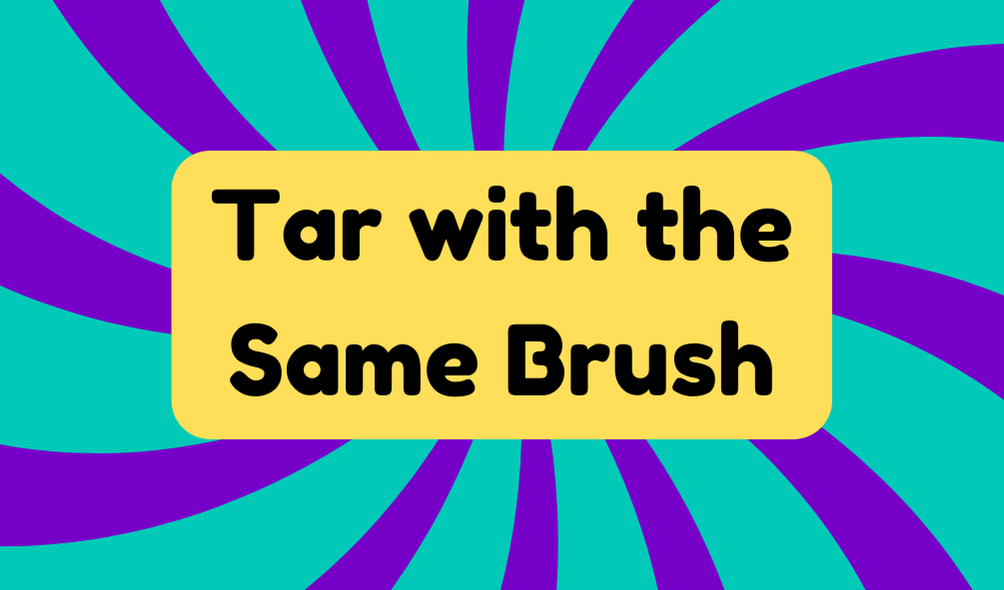The phrase "tar with the same brush" highlights the unfair practice of judging individuals based on group traits or behaviors. This tendency leads to generalizations that ignore unique qualities, fostering prejudice and discrimination. Originating in the 17th century, the metaphor suggests a simplistic approach that undermines individual identities. Today, such biases are still prevalent in various contexts, from education to the workplace. Recognizing these harmful assumptions is essential for promoting empathy and diversity. Acknowledging that not all group members share the same characteristics is fundamental for more inclusive interactions, as you will discover further.
Synonyms
When exploring alternatives to the phrase "tar with the same brush," several synonyms encapsulate the essence of unfounded generalizations based on group characteristics. These terms reflect the tendency to make unfair assumptions about individuals based solely on group stereotypes. Here are three notable alternatives:
- Stereotype – This term signifies an oversimplified image or idea about a particular group, often neglecting individual nuances.
- Generalization – This word highlights the act of applying broad conclusions to specific cases, often overlooking individuality.
- Prejudice – Prejudice involves a preconceived opinion not based on reason or actual experience, reinforcing unfair group biases.
These alternatives shed light on the damaging impact of unfair assumptions, urging a reevaluation of our social perceptions in favor of a more nuanced understanding of individual identity.
Example of Sentences
Unfair assumptions based on group characteristics can lead to misrepresentations and damaging stereotypes. Recognizing diverse realities requires precise language and contextual usage. Here are a few example sentences that illustrate the dangers of broad generalizations:
- "Don't tar all politicians with the same brush; some are genuinely working for positive change."
- "Just because one chef burned the toast doesn't mean all chefs should be tarred the same."
- "Let's not tar all cats with the same brush just because one scratched the sofa."
These sentence variations demonstrate how misinterpretation can emerge from simplistic categorizations, reminding us of the importance of addressing individuals based on their unique contributions. Emphasizing personal qualities over group traits fosters a more inclusive and innovative environment.
Origin
The idiom "tar with the same brush" traces its origins to the 17th century, rooted in the practical task of applying tar to wooden structures for protection and consistency. This historical context informs its current metaphorical imagery, which reflects the unfair judgment of individuals based on group affiliations. The idiom encapsulates a tendency to dismiss individuality, often leading to erroneous assumptions.
| Practical Use | Metaphorical Application |
|---|---|
| Sealing wooden beams | Associating negative traits |
| Ensuring uniformity | Painting groups unfairly |
| Protection against decay | Generalizing characteristics |
| Used in construction | Social and cultural judgments |
As society advances, the importance of recognizing individual merit over collective assumptions cannot be overstated. Understanding this idiom challenges us to reflect critically on our judgments.
Collocations
Numerous collocations enrich the understanding of the idiom "tar with the same brush," highlighting the nuances of its usage in various contexts. Recognizing specific collocation examples aids in grasping the phrase's implications better. Key contexts include:
- Generalization – Indicates the unfair treatment of a group based on a few.
- Judgment – Reflects societal tendency to assess individuals based on collective traits.
- Perception – Illustrates how biases about one can distort views of many.
These usage contexts reveal a critical lens on the habit of oversimplifying complex human behaviors. By analyzing collocations, we nurture skepticism towards blanket assumptions, encouraging a deeper understanding of individual nuances, rather than conforming to conventional prejudices that lead us astray in our judgments.
How to Use in Everyday Language
Understanding how to utilize the expression "tar with the same brush" in everyday language fosters more precise communication and enhances interpersonal relationships. This idiom warns against generalizing individual behaviors based on group characteristics, encouraging critical thinking. Employing the phrase effectively requires recognizing its phrasing nuances, particularly in discussions around social justice. Below is a table illustrating contexts where the phrase can be appropriately applied:
| Context | Example Sentence |
|---|---|
| Politics | "Don't tar all politicians with the same brush." |
| Gaming | "Avoid tarring all gamers due to a few negative instances." |
| Cooking | "One bad meal shouldn't define all chefs." |
| Personal Traits | "Don't assume all introverts dislike social events." |
| Public Perception | "Let's not generalize based on limited experiences." |
Mindful use of this expression promotes fairness and understanding.
Why Is It Still Relevant Today?
Why does the phrase "tar with the same brush" continue to resonate in contemporary discourse? In our increasingly interconnected world, social biases and group generalization remain prevalent, impacting how individuals perceive one another. This phrase serves as a reminder of the dangers inherent in judging people solely based on their affiliations. In educational settings, workplaces, and social interactions, unfairly applying negative traits from one individual to an entire group perpetuates stereotypes and hampers innovation. This way of thinking promotes division rather than collaboration, stifling progress. By critically evaluating the relevance of this expression today, we foster a more nuanced understanding of individual identity, urging each person to be seen beyond the limitations of their group. This encourages empathy and promotes diversity in thought and action.







